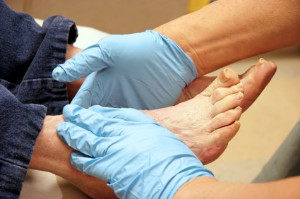159 North 3rd Street
Macclenny, Florida 32063

Nerve and circulatory damage resulting from diabetes is common and can lead to injuries to the feet and lower legs. In extreme cases, amputation is required. Amputations are the end result of foot or leg ulcers that did not heal or cannot heal. Diabetic neuropathy and peripheral artery disease (PAD) are contributing factors to this occurrence. Neuropathy makes it hard to detect cuts and sores, which may become infected. PAD then slows the healing process, causing ulcers, which if left unattended can lead to gangrene. At some point removing the ulcerated area can give way to removing the foot or limb. The two main actions that may help to keep this chain reaction from occurring are blood sugar maintenance and proper foot care. Reducing stress and eating healthy food is a good beginning. Refraining from smoking and alcohol consumption, both of which contribute to nerve damage and poor circulation, is highly recommended by experts. Losing weight and keeping track of blood sugar levels is essential. Daily foot care is imperative, including keeping feet clean and dry and checking for sores, cuts, and blisters. Moving the toes and feet to encourage better blood flow and wearing shoes that fit properly also help. If you have questions regarding proper diabetic foot care, please visit a podiatrist as soon as possible.
Diabetic Limb Salvage
Diabetic limb salvage can be an effective way in preventing the need for limb amputation. If you have a foot ulcer and diabetes, consult with Dr. John L. Coleman from Florida. Our doctor will assess your condition and provide you with quality foot and ankle treatment.
What Is Diabetic Limb Salvage?
Diabetic limb salvage is the attempt of saving a limb, such as the foot, that has an infected ulcer, from amputation. Podiatrists also try to make sure that there is enough function in the foot after the salvage that it is still usable. Those with diabetes experience poor blood circulation, which prevents proper healing of an ulcer. If the ulcer is left uncheck, it could become infected, which could result in the need for amputation.
Diabetes is the number one cause of non-traumatic amputations in the United States. Amputation has been found to lead to higher mortality rates. This translates into higher healthcare costs, and a reduced quality of life and mobility for amputees. Podiatrists have attempted to increase the prevalence of limb salvage in an attempt to solve these issues.
Diagnosis and Treatment
Limb salvage teams have grown in recent years that utilize a number of different treatments to save the infected limb. This includes podiatrists that specialize in wound care, rehabilitation, orthotics, and surgery. Through a combination of these methods, limb salvage has been found to be an effective treatment for infected limbs, and as an alternative to amputation. Podiatrists will first evaluate the potential for limb salvage and determine if the limb can be saved or must be amputated.
If you have any questions, please feel free to contact our office located in Macclenny, FL . We offer the newest diagnostic and treatment technologies for all your foot care needs.